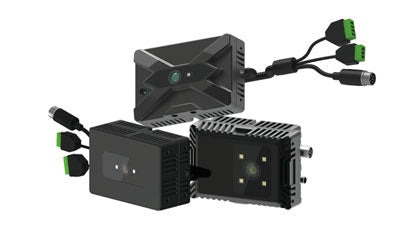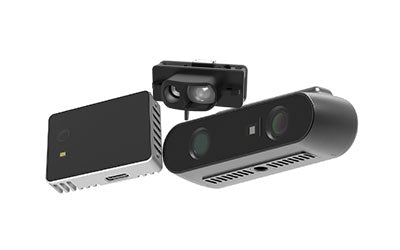TOF-Powered Semiconductor Chips: Advancing Smart Sensing and Precision
With the rapid development of technology, semiconductor microchips have become an indispensable core component of modern electronic devices. Whether it’s smartphones, computers, autonomous driving systems, or electric vehicles, semiconductor chips play a crucial role. In modern automation and intelligent devices, the application of TOF (Time of Flight) technology, especially in combination with semiconductor chips, is driving transformation across industries. TOF technology, with its precise depth sensing and real-time response, has become one of the core technologies in smart devices and autonomous driving.
1. What are Semiconductor Microchips? Their Role and Applications
A semiconductor microchip is a miniaturized electronic component made from semiconductor materials such as silicon and germanium. These materials allow precise control between conductive and non-conductive states, enabling the chip to perform various tasks such as computation, processing, and signal control.
Semiconductor microchips are widely used across various fields, playing a pivotal role in modern electronics. Specifically, their applications include:
-
Computers and Smart Devices: Semiconductor microchips are the processing cores of computers, smartphones, tablets, and other electronic devices, responsible for data processing, storage, and computation.
-
Automotive Electronics: In smart vehicles and autonomous driving technology, semiconductor microchips process data from sensors (such as cameras, radar, and TOF sensors) to support navigation, environmental perception, path planning, and safety systems.
-
Consumer Electronics: In devices such as televisions, household appliances, gaming consoles, and audio systems, semiconductor chips control and optimize various functions to enhance the user experience.
-
Communication Equipment: Semiconductor microchips are used in communication devices such as smartphones and routers, enabling wireless communication, signal processing, and data transmission.
-
Medical Equipment: In devices like pacemakers, blood glucose monitors, and medical imaging systems, semiconductor chips handle signal processing, data acquisition, and monitoring functions.
-
Industrial Automation and Robotics: In industrial automation, robotics, and manufacturing equipment, semiconductor chips process real-time data, control systems, and manage sensors.
-
IoT Devices: Semiconductor chips enable various smart devices (such as smart homes, smart city infrastructure, and health monitoring systems) to connect, communicate, and operate autonomously.
-
Energy Management: In solar power, wind energy, and other energy systems, semiconductor microchips are used for energy conversion, management, and optimization.
Semiconductor microchips are the foundation of modern technology, pervasive in almost every aspect of daily life and are driving the advancement of various industries.
2. TOF Technology: The Key to Building Precise Environmental Sensing
TOF (Time of Flight) technology is a method based on measuring the time it takes for a light signal to travel from the source to an object and then back to the sensor, calculating the distance. The principle is to emit a light signal and measure the time it takes for the signal to return, thus determining the distance between the object and the sensor. This technology has unique advantages in depth sensing and 3D imaging, making it widely applied in many smart devices, particularly in autonomous driving, robotics, augmented reality (AR), and virtual reality (VR).
The main advantages of TOF technology include:
-
High Precision: TOF sensors can provide sub-millimeter level measurement accuracy.
-
Fast Response: They can capture real-time information on dynamic objects, making them ideal for detecting high-speed moving objects.
-
All-Weather Operation: TOF technology is independent of ambient light, allowing it to function well in both low-light and bright environments, making it highly adaptable.
These characteristics make TOF technology an ideal choice for smart cars, robots, drones, facial recognition, and other fields.
3. The Combination of Semiconductor Microchips and TOF Technology: Empowering Smart Cars and Autonomous Driving
In the field of autonomous driving, the combination of semiconductor microchips and TOF technology provides powerful perception capabilities for smart cars, accelerating the development of autonomous driving technologies.
Autonomous vehicles need to perceive their surrounding environment in real-time and make intelligent decisions to ensure safe operation. TOF technology plays a critical role by emitting laser or infrared signals and receiving reflections to accurately calculate the distance to objects, thus helping autonomous systems build 3D models of the environment.
Smart cars equipped with TOF sensors can quickly scan the road ahead, detect obstacles, pedestrians, and other vehicles in real-time, generating accurate depth information and constructing environmental models. This technology enables autonomous driving cars to react faster and more accurately, facilitating actions like obstacle avoidance, path planning, lane keeping, and automated parking.
In this process, semiconductor microchips play a crucial role. Not only do they process the depth data from TOF sensors, but they also need to fuse information from various sensors (such as cameras, LiDAR, and ultrasonic sensors) to ensure that the environmental data is highly accurate and consistent. Semiconductor chips, through efficient data processing, integrate depth data, image information, and motion data, providing precise environmental perception and decision-making support to the autonomous driving system, ensuring the vehicle can navigate complex road environments accurately.
Applications of Semiconductor Chips and TOF Technology in Autonomous Driving:
-
Obstacle Detection and Avoidance:
Autonomous vehicles use TOF sensors to detect obstacles ahead and calculate their distance, position, and size. The precise depth measurement ability of TOF sensors enables the system to quickly assess the nature of obstacles (such as pedestrians, vehicles, or stationary objects) and, through semiconductor chips, rapidly compute avoidance paths. This is especially important in complex urban environments, where sudden events like pedestrians crossing the road or other vehicles suddenly stopping may occur. -
Precise Navigation and Path Planning:
TOF sensors enable the autonomous system to obtain 3D depth data of the surrounding environment. This data is processed by semiconductor chips and fused with other sensor data (such as cameras and radar) to provide more accurate map data and road conditions. Semiconductor chips' ability to process these data quickly allows the autonomous system to plan the optimal path, avoid complex traffic conditions, and ensure safety and comfort during driving. On highways, TOF technology can accurately detect potential obstacles or traffic signs, providing real-time feedback to optimize travel routes. -
Driver Monitoring and In-Car Environment Sensing:
Besides external environment sensing, TOF technology can also be used in in-car driver monitoring systems. With in-car TOF sensors, the autonomous system can monitor the driver's state, such as fatigue, facial expression changes, and eye movements. After processing this data, semiconductor chips can accurately assess whether the driver is alert. If the system detects signs of fatigue, it can issue a warning or prompt the driver to take control, ensuring driving safety. -
Dynamic Environmental Adaptation and Real-Time Decision Making:
Autonomous vehicles face constantly changing environments, and how to quickly and accurately adapt to these changes is a huge challenge. TOF technology provides accurate depth data, helping the system detect changes in road conditions, such as uneven surfaces, water accumulation, or landslides. -
With the powerful data processing capabilities of semiconductor chips, the system can quickly react and adjust driving strategies. For example, when encountering sudden obstacles or traffic changes, the system can immediately recognize and initiate emergency maneuvers, ensuring the safety of the driver and passengers.
-
Cross-Domain Sensor Fusion and Intelligent Decision Support:
Semiconductor chips are not only the core of data processing but also play a key role in sensor fusion. Autonomous vehicles are often equipped with multiple sensors, such as TOF sensors, LiDAR, high-definition cameras, and ultrasonic sensors. The information from these sensors is integrated and processed by semiconductor chips. Through cross-domain data fusion, semiconductor chips can accurately assess various factors in the environment, eliminate errors, and improve the accuracy of environmental perception, providing precise decision-making support for the vehicle. This efficient data processing and fusion technology is one of the key elements for achieving fully autonomous driving.
The combination of semiconductor chips and TOF technology is undoubtedly a significant driving force in the development of autonomous driving technology. TOF technology provides precise depth sensing for autonomous vehicles, while semiconductor chips ensure the efficient operation of the system through powerful data processing and sensor fusion. As technology continues to evolve and costs decrease, we can expect autonomous vehicles in the future to be smarter, safer, and increasingly reliant on the integration of TOF technology and semiconductor chips, laying a solid foundation for intelligent transportation systems.
4. Other Application Scenarios for Semiconductor Chips and TOF Technology
The combination of semiconductor microchips and TOF technology is not limited to autonomous driving, as it also finds wide applications in other fields:
1. Smartphones and Smart Homes:
Functions such as facial recognition, gesture control, and AR (augmented reality) applications in smartphones can be realized with TOF technology. TOF sensors can quickly capture facial features to provide accurate identity verification. At the same time, semiconductor chips process large amounts of image and depth information to ensure fast device responses.
In the smart home domain, TOF technology is used for environmental sensing and human-machine interaction. For instance, TOF sensors can recognize hand gestures to control smart home devices. Semiconductor chips process the data efficiently and provide real-time feedback, enhancing the device's intelligence.
2. Robots and Drones:
Robots and drones require high precision in spatial sensing, and TOF technology provides them with 3D depth data. Whether for indoor navigation robots or aerial drones, TOF sensors help them avoid obstacles and precisely locate targets. Semiconductor chips play a critical role in data processing and instruction transmission, ensuring efficient operation.
3. Industrial Automation and Production Line Monitoring:
In industrial automation, the combination of TOF technology and semiconductor chips is used for object recognition, quality control, and precision measurement. For example, TOF sensors can quickly measure whether products on a production line meet specifications, while semiconductor chips analyze the data and make corresponding adjustments to ensure product quality.
5. Semiconductor Trends: The Integration of TOF Technology and the Path to Smart Systems
As technology continues to advance,
the integration of semiconductor chips and TOF technology is expected to expand further. In the future, more fields will benefit from the enhanced depth sensing, faster processing, and lower cost solutions provided by these technologies. Whether it is the industrial field, smart home systems, autonomous driving, or robotics, this integration will bring new opportunities and lead to more precise, faster, and smarter systems.
Conclusion: The Future of Semiconductor Chips and TOF Technology in Smart Systems
The integration of semiconductor microchips with TOF technology is revolutionizing the way we perceive and interact with the world. With rapid advancements in both fields, we are set to witness the rise of intelligent systems that operate with greater precision, autonomy, and adaptability. As this synergy deepens, industries such as autonomous driving, robotics, smart homes, and industrial automation will continue to evolve, fostering a new era of innovation powered by semiconductor microchips and TOF technology.
Synexens 3D Of RGBD ToF Depth Sensor_CS30
Our professional technical team specializing in 3D camera ranging is ready to assist you at any time. Whether you encounter any issues with your TOF camera after purchase or need clarification on TOF technology, feel free to contact us anytime. We are committed to providing high-quality technical after-sales service and user experience, ensuring your peace of mind in both shopping and using our products.



